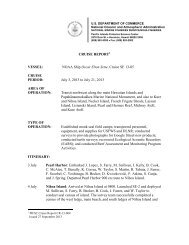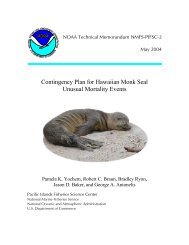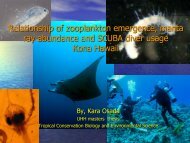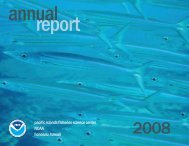Shark Predation on Hawaiian Monk Seals - Pacific Islands Fisheries ...
Shark Predation on Hawaiian Monk Seals - Pacific Islands Fisheries ...
Shark Predation on Hawaiian Monk Seals - Pacific Islands Fisheries ...
You also want an ePaper? Increase the reach of your titles
YUMPU automatically turns print PDFs into web optimized ePapers that Google loves.
example, a single tiger shark was <strong>on</strong>ly recaptured after five attempts, whereas another was<br />
recaptured <strong>on</strong> the first try. Regarding the poor success in capturing Galapagos sharks near Trig<br />
Islet in the past (presumably efforts by HMSRP and HIMB), it was explained that Galapagos<br />
sharks just have not been frequently seen in the area where gear has been set. If deterrents are<br />
applied and shark movement change is detected, cause and effect will be difficult to discern,<br />
because sharks may have been intending to vacate any area <strong>on</strong> their own anyway and not<br />
necessarily in resp<strong>on</strong>se to the deterrent itself.<br />
<strong>Hawaiian</strong> M<strong>on</strong>k Seal Perspective<br />
The following topics were presented <strong>on</strong> the HMSRP’s shark predati<strong>on</strong> mitigati<strong>on</strong> efforts in<br />
2008:<br />
Descripti<strong>on</strong> and results of the deterrent and device trials<br />
Evaluati<strong>on</strong> of successes, challenges, limitati<strong>on</strong>s encountered and expected in mitigating<br />
Galapagos shark predati<strong>on</strong> in the future<br />
Summary of <str<strong>on</strong>g>Shark</str<strong>on</strong>g> Deterrent and N<strong>on</strong>-Physical Barriers Deployed at FFS, 2008<br />
Kathleen Gobush, PhD, <strong>Hawaiian</strong> M<strong>on</strong>k Seal Research Program<br />
In 2008, HMSRP deployed a suite of implements that included electromagnetic and magnetic<br />
deterrents and auditory and visual devices based <strong>on</strong> the recommendati<strong>on</strong>s from Workshop I<br />
(NMFS, in prep.). For this pilot study, HMSRP decided that the suite approach was the most<br />
logical means to test the feasibility of these devices and protect the most pups. Alternatively,<br />
each device could have been deployed <strong>on</strong>e at a time to test its effect; however, the total<br />
expected number of incidents across the short window of time of applicati<strong>on</strong> (c<strong>on</strong>fined to the<br />
pupping seas<strong>on</strong>, late May–August) would preclude robust statistical analysis. Thus, it was<br />
decided that, initially, a suite of devices would be applied with the opti<strong>on</strong> to incrementally<br />
remove or add certain devices in future trials based <strong>on</strong> preliminary observati<strong>on</strong>s made during<br />
the pilot study. Devices deployed with possible shark deterring capability included:<br />
Ceramic magnets<br />
<str<strong>on</strong>g>Shark</str<strong>on</strong>g> Shield ® electromagnetic devices<br />
Auditory and visual devices deployed included:<br />
Boat sounds emitted underwater<br />
A small, anchored boat<br />
Floats and buoy array, deployed in associati<strong>on</strong> with the ceramic magnets<br />
Magnets and electromagnetic devices exploit the capability of elasmobranchs to perceive<br />
electromagnetic fields with their ampullae of Lorenzini. These are gel-filled pores<br />
homogeneously distributed around the nose and mouth of the shark. In the presence of an<br />
electric field, the electric potential at the surface of the prey differs from the electric potential of<br />
the interior of the animal, which is detectable by the shark (http://www.shark.co.za). Galapagos<br />
sharks are less likely to bite bait in the presence of large electric fields (St<strong>on</strong>er and Kaimmer, in<br />
press), so items which create such fields may serve as repellents. Both the cermaic magnets and<br />
<str<strong>on</strong>g>Shark</str<strong>on</strong>g> Shields artifically create electromagnetic fields in water. Magnets are expected to be<br />
11
















